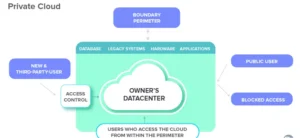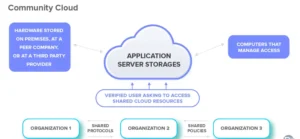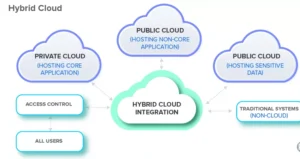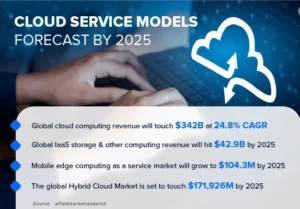Today, organizations have plenty of exciting opportunities to reimagine, repurpose and reinvent their businesses with the cloud. The last decade has seen even more businesses rely on it for quicker time to market, better efficiency and scalability. It helps them achieve long-term digital goals as part of their digital strategy.
Though the answer to which cloud model is an ideal fit for a business depends on the computing and business needs of your organization. Choosing the right one from the various types of cloud service deployment models is essential. This would ensure your business is equipped with the performance, scalability, privacy, security, compliance & cost-effectiveness it requires. It is important to learn and explore what different deployment types can offer – around what particular set of problems it can solve.
Read on as we cover the various cloud computing deployment and service models to help discover the best choice for your business.
Table of Contents:
- What is a cloud deployment model?
- Different Types of Cloud Computing Deployment Models
- Public
- Private
- Community
- Hybrid
- Comparative Analysis of Cloud Deployment Models
- Service models of cloud computing
- Making the Right Choice for Cloud Deployment Models
What Is A Cloud Deployment Model?
It works as your virtual computing environment with a choice of deployment model depending on how much data you want to store and who has access to the infrastructure.
Different Types Of Cloud Computing Deployment Models
Most cloud hubs have tens of thousands of servers and storage devices to enable fast loading. It is often possible to choose a geographic area to put the data “closer” to users. Thus, deployment models for cloud computing are categorized based on their location. To know which model would best fit the requirements of your organization, let us first learn about the various types.
Public Cloud
The name says it all. It is accessible by the public. Public deployment models in the cloud are perfect for organizations with growing and fluctuating demands. It also makes a great choice for companies with low-security concerns. Thus, you pay a cloud service provider for networking services, compute virtualization & storage available on the public internet. This is also a great delivery model for the teams with development and testing. Its configuration and deployment are quick and easy, making it an ideal choice for test environments.

Benefits of Public Cloud
- Minimal Investment – As a pay-per-use service, there is no large upfront cost and is ideal for businesses who need quick access to resources
- No Hardware Set-up – The entire infrastructure is fully funded by the cloud service providers
- No Infrastructure Management – Does not require an in-house team to utilize the public cloud
Limitations of Public Cloud
- Data Security and Privacy Concerns – Since it is accessible to all, it does not fully protect against cyber-attacks and could lead to vulnerabilities
- Reliability Issues – Since the same server network is open to a wide range of users, it can lead to malfunction and outages
- Service/License Limitation – While there are many resources that you can exchange with tenants, there is a cap on usage
Private Cloud
Now that you understand what the public cloud could offer you, of course, you are keen to know what a private cloud can do. Companies that look for cost efficiency and greater control over data & resources will find the private cloud a more suitable choice.
What it means is that it will be integrated with your data center and managed by your IT team. Alternatively, you can also choose to host it externally. When it comes to customization, the private cloud offers bigger opportunities that help meet specific organization’s requirements. It’s also a wise choice for mission-critical processes that may have frequently changing requirements.

Benefits of Private Cloud
- Data Privacy – It is ideal for storing corporate data where only authorized personnel gets access
- Security – Segmentation of resources within the same infrastructure can help with better access and higher levels of security
- Supports Legacy Systems – This model supports legacy systems that cannot access the public cloud
Limitations of Private Cloud
- Higher Cost – With the benefits that you get, the investment will also be larger than the public cloud. Here, you will pay for software, hardware and resources for staff and training.
- Fixed Scalability – The hardware you choose will accordingly help you scale in a certain direction
- High Maintenance – Since it is managed in-house, the maintenance costs also increase
Community Cloud
The community cloud operates in a way that is similar to the public cloud. There’s just one difference – it allows access to only a specific set of users who share common objectives and use cases. This type of deployment model of cloud computing is managed and hosted internally or by a third-party vendor. However, you can also choose a combination of all three.

Benefits of Community Cloud
- Smaller Investment – A community cloud is much cheaper than the private & public cloud and provides great performance
- Setup Benefits – The protocols and configuration of a community cloud must align with industry standards. This allows customers to work much more efficiently
Limitations of Community Cloud
- Shared Resources – Due to restricted bandwidth and storage capacity, community resources often pose challenges
- Not as Popular – Since this is a recently introduced model, it is not that popular or available across industries
Hybrid Cloud
As the name suggests, a hybrid cloud is a combination of two or more cloud architectures. While each model in the hybrid cloud functions differently, it is all part of the same architecture. Further, as part of this deployment of the cloud computing model, the internal, or external providers can offer resources.
Let’s understand the hybrid model better. A company that has critical data will prefer storing on a private cloud, while less sensitive data can be stored on a public cloud. The hybrid cloud is also frequently used for ‘cloud bursting’. It means, suppose an organization runs an application on-premises, but due to heavy load, they can burst into the public cloud.

Benefits of Hybrid Cloud
- Cost-Effectiveness – The overall cost of a hybrid solution decreases since it majorly uses the public cloud to store data
- Security – Since data is properly segmented, the chances of data theft from attackers is significantly reduced
- Flexibility – With higher levels of flexibility, businesses can create custom solutions that fit their exact requirements
Limitations of Hybrid Cloud
- Complexity – It is complex setting up a hybrid cloud since it needs to integrate two or more cloud architectures
- Specific Use Case – This model makes more sense for organizations that have multiple use cases or need to separate critical and sensitive data
A Comparative Analysis Of Cloud Deployment Models
With the below table we’ve attempted to analyze the key models with an overview of what each one can do for you;
| Important Factors to Consider | Public | Private | Community | Hybrid |
| Setup and ease of use | Easy | Requires professional IT Team | Requires professional IT Team | Requires professional IT Team |
| Data Security and Privacy | Low | High | Very High | High |
| Scalability and flexibility | High | High | Fixed requirements | High |
| Cost Effectiveness | Most affordable | Most expensive | Cost is distributed among members | Cheaper than private but more expensive than public |
| Reliablility | Low | High | Higher | High |
3 Service Models Of Cloud Computing
Cloud computing makes it possible to render several services, which can be defined according to the roles, service providers and user companies. Cloud computing models and services are broadly classified as below:
IAAS: Changing Its Hardware Infrastructure on Demand
The Infrastructure As A Service (IAAS) means the hiring & utilizing of the physical infrastructure of IT (network, storage, and servers) from a third-party provider. The IT resources are hosted on external servers and users can access them via an internet connection.
The Benefits
- Time and cost savings: No installation and maintenance of IT hardware in-house,
- Better flexibility: On-demand hardware resources that can be tailored to your needs,
- Remote access and resource management.
For Who?
This cloud computing service model is ideal for large accounts, enterprises, or organizations capable of building and managing their own IT platforms. However, they want the flexibility to amend their infrastructure according to their needs.
PAAS: Providing a Flexible Environment for Your Software Applications
Platform as a Service (PAAS) allows outsourcing of hardware infrastructure as well software environment, which includes databases, integration layers, runtimes and more.
The Benefits
- Focus on development: Mastering the installation and development of software applications
- Time saving and flexibility: no need to manage the implementation of the platform, instant production.
- Data security: You control the distribution, protection, and backup of your business data.
For Who?
It is ideal for companies wanting to maintain control over their business applications. However, they wish to get rid of constraints to manage the hardware infrastructure and software environment.
SAAS: Releasing the User Experience of Management Constraints
Software as a Service (SaaS) is provided over the internet and requires no prior installation. These services can be availed from any part of the world at a minimal per-month fee.
The Benefits
- You are entirely free from the infrastructure management and aligning software environment: no installation or software maintenance.
- You benefit from automatic updates with the guarantee that all users have the same software version.
- It enables easy and quicker testing of new software solutions.
For Who?
SAAS model accounts for 60% of sales of cloud solutions. Hence, it is applicable and preferred by most companies.

Making The Right Choice For Cloud Deployment Models
There is no one-size-fits-all approach to picking a cloud deployment model. Instead, organizations must select a model based on workload-by-workload. Start with assessing your needs and consider what type of support your application requires. Think about your business goals as well. What is it that you want to achieve? Understand that it is also possible that your requirements may change over time.
Here are a few factors you can consider before making the call:
- Ease of Use – How savvy and trained are your resources? Do you have the time and the money to put them through training?
- Cost – How much are you willing to spend on a deployment model? How much can you pay upfront, on subscription, maintenance, updates and more?
- Scalability – What is your current activity status? Does your system run into high demand
- Compliance – Are there any specific laws or regulations in your country that can impact the implementation? What are the industry standards that you must adhere to?
- Privacy – Have you set strict privacy rules for the data you gather?
Closing Thoughts
Each cloud deployment model has a unique offering and can immensely add value to your business. For small to medium-sized businesses, a public cloud is an ideal model to start with. And as your requirements change, you can switch over to a different deployment model. An effective strategy can be designed depending on your needs using the above-mentioned cloud deployment models.
Why Choose kenmugrage Software?
kenmugrage Software is a technology services partner that helps customers achieve new growth levels through cloud-native services. We offer an array of cloud services and deployment models to choose from. Our continued success as a cloud app development company makes us the perfect partner for your business needs. We use our extensive experience & knowledge of cloud technologies to deliver on projects of any scale & complexity.




